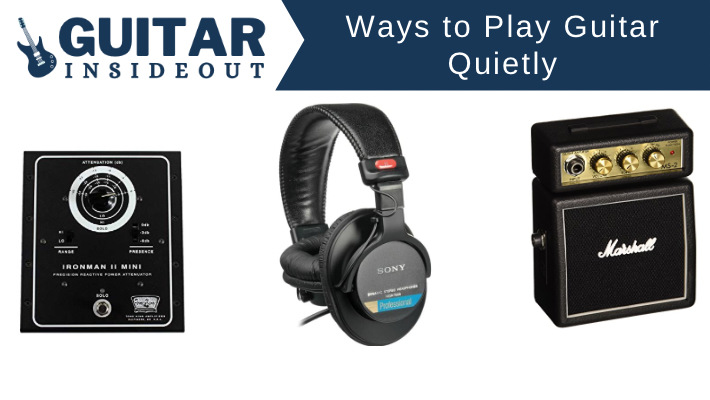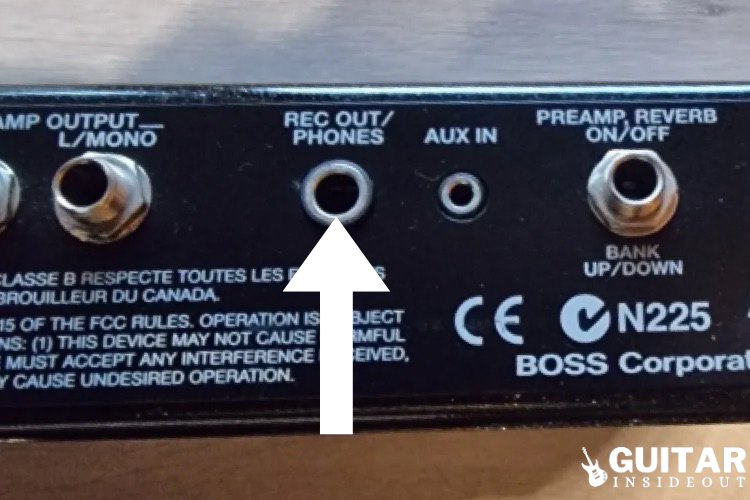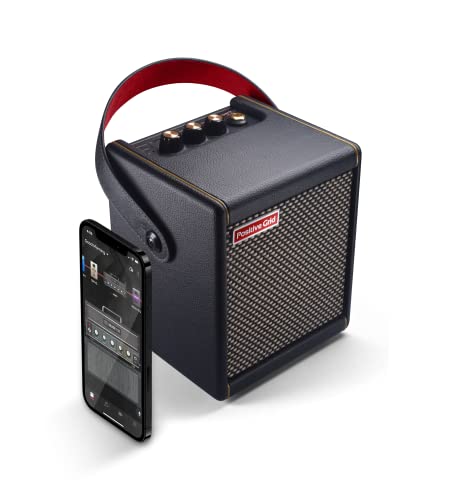Playing guitar quietly but still sounding good is something many of us want. A lot of us, myself included, are bedroom guitarists and not gigging professionals.
So we want ways to play the guitar in our homes and bedrooms that doesn’t sacrifice tone but also isn’t too loud and doesn’t annoy family or neighbors. So what’s the solution?

I’ve been through the many different options you’ve got to play quietly at home and tried them out for you. And so I’m going to discuss here which I think are the best and which ultimately don’t work very well.
Ways to Play Electric Guitar Quietly
Electric guitars are generally louder than acoustics. So we’ll start with solutions to playing electric guitar quietly.
Play Unplugged
The most basic way to play guitar quietly – don’t plug your electric guitar in!
While it’s not the best way to practice – you aren’t learning how to mute and avoid strings noise etc – if needs must then it’s the simplest way to play without annoying anyone else.
I wouldn’t recommend it being the only way you practise. You will definitely want to plug in to an amp sometimes.
But playing unplugged is easy. You can sit on the sofa whilst watching TV and do it, practise the normal way you usually do just without using an amp and never annoy or upset anyone even remotely close to you.
Use Headphones
So many amplifiers come with the ability to play through headphones. It’s not a traditional way of playing so you won’t find a headphone jack on the more vintage style amps. But most modern amplifiers, both tube and solid state, have the option.

And it’s a really good development because it makes playing without upsetting neighbors and family members a breeze! Get yourself a decent pair of headphones and you can play for hours without anyone being disturbed.
I use a pair of Sony MDR-7506’s which aren’t too expensive but also not exactly cheap. But I really like them and they sound good to me.
I don’t think you want to go too cheap with headphones though. It’s worth splashing out a little when you’re trying to find a solution to playing quietly. The lays thing you want is your solution has awful sound quality.

Turn your Amp Down
This may sound obvious but amplifiers have volume controls. So you can just turn it down until it’s not too loud.
Where this doesn’t work is if you want to play with gain and your amp only has a volume control. It’s close to impossible to get natural overdrive without pushing an amp and that means you will need volume.
But if your amp has a master volume and channel volume controls or a separate gain and volume control then it’s relatively easy to keep the gain up and the volume down. The downside to doing this is it usually doesn’t sound very good.
You’ll be sacrificing tone for low volume, especially if it’s a tube amp. Solid state amps are much better at lower volume due to the way they work, although many guitarists play tube amps simply turned down (myself included).
A lot of the time it depends on the amp itself. Some are known for sounding terrible unless they’re being played at higher volume and others work great when turned down.
And some amps have terrible volume controls. The sort that go from whisper quiet to ludicrously loud with the slightest turn. The old Fender Blues and Hot Rod Deluxe’s were well known for this to the point that a mod to fix it was/is extremely common.
But if you get an amp with a good taper to it’s volume control then there’s nothing to stop you simply keeping it low. It’s may not be the best choice for playing quietly but it’s certainly an easy one.
If you want a tube amp for using at home have a look at my guide to the 7 best tube amps for home use.
Mini Amps
In recent years there has been a rise in mini and micro amps. I remember close to 20 years ago I got a Marshall Micro amplifier to use at university and really didn’t like it. In fact it put me off these tiny amps for years.

But I’m pleased to say they’ve got a lot better. You can now get amps like the Blackstar Fly 3, Positive Grid Spark Mini and Yamaha THR5 or THR10 and they’re all far better than their toy-like appearance might have you think.
These are tiny amplifiers that sit comfortably on desktops or are portable enough so they can be taken with you when you travel. They all take batteries, have headphone jacks and can be kept at very low volume levels without sounding terrible.
Yes, they’re never going to sound as good as a the cleans on a Fender Twin Reverb or the gain of a Mesa Boogie Dual Rectifier. But for playing at home or if you’re travelling they’re surprisingly good.

I really like the Yamaha THR series – the THR5 is the scaled down version and offers some great tones for a very resonance price. Its bigger brother, the THR10, is even better and sounds great at all volumes.

The Positive Grid Spark Mini is one of the newer options and takes the innovation of the original Positive Grid Spark and puts it in an even smaller, portable package.
And the Blackstar Fly 3 is considered a bit of a classic by now! Tiny and powerful, hooking it up to the mini extension cabinet provides a ridiculously good sound.

There are loads more options too, those are just a few of my favorites. You can even get ‘proper’ tiny amps like the Orange Micro Terror (which I own – read my review here) and Fender Mustang LT25 or Boss Katana Mini.
They’re more like actual amplifiers but still much smaller in size and produce some great sounds. I really like my Micro Terror. It’s a bit of a one trick pony but it does that one specific sound really well!
There’s also the new ‘amp plugs’ that are very small amps that plug into your guitar but are extremely portable. The Vox AmPlug is one of the most popular and is perfect for quiet playing, saving space and travelling.

So if you’re short on space or need a quiet amp for playing at home then one of the mini amps could be just what you’re searching for.

Use an Attenuator
Attenuators are clever little things. They sort of the trick amplifiers into thinking they’re playing a lot louder than they really are.
An attenuator will take the wattage of the amp and reduce it. This allows you to turn up the amp and push it harder without the huge increase in volume.
If you’ve got a tube amp that you can’t tame then an attenuator will do the job for you.
Don’t be fooled though: an attenuator won’t make a 100 watt amp sound exactly the same when turned up loud. There’s no way to get that feeling and sound from a big amp pushing air.
And they do suffer from ‘tone suck’. Sadly there’s no real way to get the exact same tone and sound from a fully cranked, big tube amp at lower volume. So the trade off in this case is it doesn’t sound as good.
But a good attenuator can still make a huge difference. And the tone not being quite as good is a trade off most of us are happy with.
I’ve got a cheap attenuator – a Harley Benton PA-100 – and it works pretty well. But with attenuators it does seem like the price is important. Basically the more you pay the better you get.
The Harley Benton is probably going to be fine if you’re just playing at home with a smaller amp. I’ve read the Bugera PS1 is decent too but haven’t tried it myself. But there are much better options that can do more and have greater features.
If I were buying a new attenuator today I’d go with the Tone King Iron Man II Mini. It’s pricey but does an amazing job. Sounds as close as you can get to your amp when really opened up.

Get an Amp with Power Scaling
Power scaling is slightly different from attenuation. It sort of turns the amp into a smaller wattage version compared to an attenuator which really just lowers the volume. So it actually changes the way the amp behaves.
Essentially what power scaling does is lower the voltage of the amp and this makes it quieter (or able to produce less volume).
Power scaling tends to be built in to the amp so with a single switch you can lower the power/wattage. On the whole I prefer power scaling to using an attenuator but it can be a bit hit or miss depending on the amp.
Power scaling tends to put less stress on the tubes as well.
Having said that lots of amps have built in attenuators and they work as well as power scaling (sometimes better).
I think power scaling is probably better for keeping an amps volume low for playing at home whereas an attenuator excels at taming a ridiculously loud amp when playing gigs or rehearsing. But many bedroom guitarists or those looking to practice at home swear by attenuators, so it’s mainly a personal choice.
A few good examples of amps with power scaling that would be perfect for playing quietly at home:
- Blackstar HT5R
- Marshall DSL5
- Bugera V5 Infinium
- And I couldn’t leave out my Orange Rocker 15 (read my review here)

Try a Load Box
I’ve not got a huge amount of experience with load boxes but I know they allow for silent or quiet playing. Unlike an attenuator they are used as a replacement for your speaker and take the tube amps “load”, that is the sound that would be coming from speaker.
The load box can then either send that signal to a power amp or you can use speaker sims with it. I liked this description from Premier Guitar of how a load box can work – “A load box can also send the loaded-down line-level amp signal to a second power amp, giving you total control over your tone and volume. Crank your amp to the sweet spot, knock it down to line level, add effects if desired, and then “reamp” the whole thing to any volume through a power amp and cab of your choice.”
As I mentioned I don’t have much experience with using load boxes so I can’t really give a proper recommendation for them. But from what I’ve read they work well, especially for recording at home.
Use Amp Sims
The advances we’ve seen in guitar technology and gear has been pretty astonishing. And the rise of software that allows you to simulate amps has been a big game changer.
I fully accept there’s nothing that can replace the feel and sound of a tube amp that’s really cooking. But a lot of the time that simply isn’t practical.
Having software that allows you to access a simulation of virtually every amp ever made and then play it at reasonable volume – that’s hard to beat! It’s like having your own limitless recording studio at your fingertips.
There are a variety of VST’s and plugins ranging from free to fairly expensive.
Amplitude and BiasFX are very popular, Neural DSP is arguably the leader in the field and the Line 6 Helix Native is amazing. There are loads more too, you can spend ages trying out different plugins and sims.
As someone who’s always used regular amps I’ve recently started experimenting with a set of studio monitors, a DAW and VST’s. I’m using the Focusrite Scarlett 2i2, Neural DSP and PreSonus Eris Studio Monitors.

It’s nothing fancy but it’s been a lot of fun to play around with. The PreSonus Eris studio monitors are great because they’re relatively inexpensive and I also use them to play music through and hook my record player up to.

Headphones work great with this sort of setup too and plug straight into the Focusrite Scarlett. So if you need total silence it’s a really good choice. Lots of fun to experiment with too!
Soundproof your Room
This is quite an extreme suggestion but it definitely works! If you can afford and have the time and skill to do it then soundproofing the room you play in will stop almost all the noise.
I haven’t done anything like this myself, I’ve only played in soundproofed rooms, so I can’t offer much in the way of guidance. Much of it seems to be about installing new doors, panels to walls etc.
Soundproofing will also work for both electric and acoustic guitars. And in fact any instrument.
It’s probably the most comprehensive solution and will work the best. But it’s not something you can do easily.
It will take planning and hard work, if it’s an option for you at all. If you rent you’re landlord isn’t going to be happy with you making significant changes to his house or apartment!
Ways to Play Acoustic Guitar Quietly
Acoustic guitars are generally quieter than electrics because you don’t usually use an amp. But even without an amplifier acoustic guitars can be loud.
So these few ideas should help you to play your acoustic guitar quietly and avoid annoying neighbors and housemates or family.
Use a Guitar Mute
You may have seen a guitar mute before and not known what it was. They look like this:

A guitar mute, also known as a practice mute or a soundhole cover, is a clever little device designed to reduce the volume from an acoustic or electric guitar. It’s either attached to the guitar’s strings, covers the soundhole or is placed directly on the strings above the soundhole.
Essentially it dampens the vibrations of the strings and in turn decreases the volume from the guitar. This allows you to practice without disturbing anyone nearby, perfect when you’re playing late at night or live with others.
Unfortunately the mute will affect your tone to some extent. But when you’re trying to minimize the volume sacrificing some of that sweet tone is unavoidable.
They’re cheap though and so you can try one out without having to spend much. Alternatively you can simply shove a load of material, old clothes or towels for example, in your sound hole.
Try an Acoustic Guitar Silencer
Similar to the mute, a silencer goes under the strings of the guitar and almost entirely mutes them. You can buy these for little cost but if you want to improvise (or you’re just a bit cheap!) the you can use something like a bit of rubber, foam or towel.

Where you position the silencer and how much it comes into contact with the strings will determine how much it mutes the sound. You can move the silencer around and find a good spot for your desired level of volume.
While this works I’m not convinced it’s a great way to play quietly. You can end up muting the strings so much that you lose any dynamics or feel.
You might even reduce the volume of your guitar so much that it’s hard to hear what you’re playing.
But it is a very cheap method and easy to try.
Play Gently
If you play your guitar gently – don’t pick and strum as hard, fingerpick or play fingerstyle etc – it will naturally be a lot quieter.
It’s not the most effective way of playing quietly but if you adapt your playing style a bit you can definitely make it quieter.
Try it now – pick up your acoustic and very gently fingerpick and a song. It’s not particularly loud at all, is it?
If you want to play heavily strum songs then this won’t work. But
Get a Travel Guitar
You might think buying a new guitar sort of defeats the point. You want to know how to play the guitar you currently own quietly, right? Not just get a new one.
And you’d be right. But sometimes there aren’t any other options. If you’ve exhausted everything else then it might be worth considering getting a travel guitar.
Travel guitars are lightweight, small and most importantly – quiet! The way they’re constructed – without the hollowbody – makes them about as quiet as an unplugged electric guitar.
You can get them in all versions – electric, steel and nylon strung.
